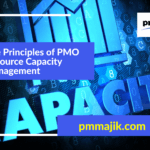Managing your resources in a major element of a well-run project management office (PMO). There are different ways that you can handle this in your office and we’re going to look at three strategies or resource capacity management in your PMO.
Every business and every PMO is different. The strategy you choose to employ will depend on your needs. It is possible to change strategy in response to the business goals or changing markets. Here, we’re going to look at:
- The principles of three resource capacity management strategies
- The benefits of each strategy
- What you need to be aware of when choosing each strategy
Allowing you and your resource capacity manager to make the right decision for your PMO.
What are the main strategies for resource capacity management for a PMO?
In general, there are three strategies that you can employ in your resource capacity management – match, lead, or lag. Each is used to react to and plan for market changes and fluctuations.
Good resource capacity planning and management will:
- Minimise idle time for your resources
- Prevent overproduction
- Avoid shortages
Let’s take a look at the each of the strategies.
1. Match planning
As the name suggests, match planning matches the capacity in your PMO with changing market demands nearly in real time. It requires constant monitoring of the business and markets and to be aware of all of the projects that are coming down the line.
It’s a moderate strategy that doesn’t have a lot of risk, but there is a lot of work involved for your office in having to be constantly in touch with capacity needs. It’s one of the most common strategies for resource capacity management.
When your PMO manages a range of projects across different timeframes and departments, this method allows you respond swiftly. A bigger PMO will be able to manage the match strategy better.
2. Lag planning
When you utilise lag planning in your PMO you are choosing to deal with capacity challenges in real time. It’s a very conservative strategy that will mean that you only bring in new capacity once you’re already operating at 100 percent.
It will mean that you have the lowest possible staffing costs, but you could sacrifice some efficiency. If you’re human resources need training and detailed onboarding, this could mean that you have to operate at over full capacity whilst waiting for new team members.
Not having enough talent on hand can derail a project’s timeline. This method of planning works best when you don’t need highly skilled colleagues available in your PMO or your resource focus isn’t primarily on people.
3. Lead planning
Lead planning is known as a radical and aggressive approach to your capacity challenges. It requires your PMO to anticipate changes in demand before they happen and bring in fresh capacity ahead of time.
This strategy allows you to prepare the business for growth. In a PMO that commissions projects as well as monitors them, it’s a strategy that can work because you’re more aware of where new project demands can come from. It’s also a good strategy to employ when you have highly skilled human requirements that have a long recruitment and onboarding process.
As a strategy, it can help a business take market share off competitors by being better prepared to respond to changes. There is, however, a need for a long-term investment and you could find your PMO being overstaffed with increased costs.
The take home
A PMO manages a lot of different resources. Human resources, along with space, computer systems, machinery, and logistics, all need to be employed efficiently across projects.
The three strategies for resource capacity management in your PMO that we’ve outlined today can be used across a range of PMO styles. Your PMO could even look to use one of the methods for one resource, and a different method for another – e.g. use lead planning for your talent needs and lag planning for your transportation needs. Whichever strategy you choose, you should see better productivity and efficiency in your office when it’s done right. Your projects will more likely come in on time and on budget with the right strategy in place.






